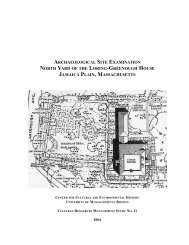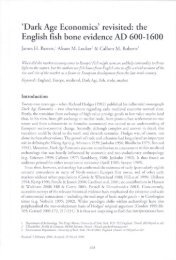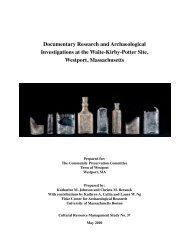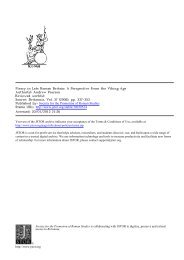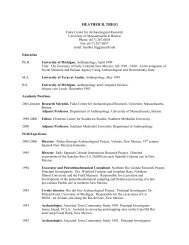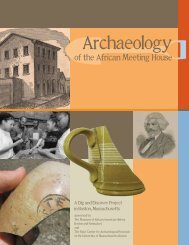Excavations at Glaumbær - Fiske Center
Excavations at Glaumbær - Fiske Center
Excavations at Glaumbær - Fiske Center
You also want an ePaper? Increase the reach of your titles
YUMPU automatically turns print PDFs into web optimized ePapers that Google loves.
whereas the klömbruhnaus and turf fill construction in the southern half of the longhouse<br />
was clearly apparent in the upper exposure suggests th<strong>at</strong> the other skáli walls may have<br />
been composed of strengur as well.<br />
Figure 2. Skáli with GPR-Slice image <strong>at</strong><br />
122.8 - 136.7 cm showing a highly<br />
reflective fe<strong>at</strong>ure in the center of the skáli.<br />
A test trench [15] bisecting the skáli was<br />
excav<strong>at</strong>ed in 2002 as part of the program<br />
investig<strong>at</strong>ing the function of the building<br />
(Steinberg 2004). The trench revealed raised<br />
pl<strong>at</strong>forms on each side of a central aisle and<br />
a compacted central floor primarily<br />
composed of pinkish-white ash and<br />
charcoal. No central hearth was indentified<br />
in test excav<strong>at</strong>ions of the skáli. The GPR-<br />
Slice images do show a candid<strong>at</strong>e for a<br />
central hearth. Loc<strong>at</strong>ed halfway along the<br />
length of the skáli, a highly reflective<br />
oblong fe<strong>at</strong>ure can be seen <strong>at</strong> multiple<br />
depths. Shown here <strong>at</strong> a depth of 122.8 -<br />
136.7 cm the fe<strong>at</strong>ure is clearly visible<br />
bene<strong>at</strong>h the highly reflective fe<strong>at</strong>ures<br />
associ<strong>at</strong>ed with the central aisle of the skáli<br />
(figure 2).<br />
North Entrance [9]<br />
The only clear external entrance to the<br />
longhouse was found in the northeastern end<br />
of the skáli. The entrance defined in<br />
excav<strong>at</strong>ion corresponds to fe<strong>at</strong>ures<br />
identified in the remote sensing. GPR-Slice<br />
images show a series of highly reflective<br />
fe<strong>at</strong>ures, possibly stones or a heavily<br />
trampled floor, curving from the central<br />
aisle of the skáli toward the entrance. At the same depth, outside the entrance is a large<br />
highly reflective fe<strong>at</strong>ure, presumably a stone paving (figure 3). However, the close<br />
associ<strong>at</strong>ion with the primary household midden [51] loc<strong>at</strong>ed approxim<strong>at</strong>ely 15 meters east<br />
of this entrance raises the possibility th<strong>at</strong> this may have been a secondary entrance. The<br />
most likely candid<strong>at</strong>e is a passage [30] leading to a room [29] in <strong>at</strong>tached to the southwest<br />
end of the skáli. The western extent of the room was not defined in excav<strong>at</strong>ion as it<br />
extends past the limit of excav<strong>at</strong>ion; see discussion of the west room below.<br />
6



